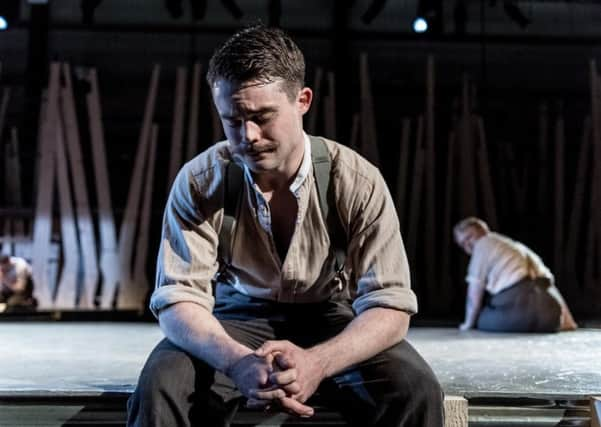Joyce McMillan: Wanted: creative visionary for the NTS


It’s been a long time coming; but last week, almost three months after the National Theatre of Scotland announced Laurie Sansom’s resignation as artistic director, the company began the process of advertising for a new artistic leader, with the hope of making an appointment in October or November this year.
To all outward appearances, Laurie Sansom’s decision to resign was sudden, and not entirely happy. He had been in the job for less than three years, a short time-span for such a major post; his massive triple production of Rona Munro’s James Plays – the huge Scottish history cycle first seen at the Edinburgh Festival of 2014 – was still on tour in England, and heading for a final run in Toronto. He was in mid-rehearsal for The 306: Dawn, an acclaimed piece of music theatre, staged in a barn in Perthshire, about three men who were shot at dawn for cowardice or desertion amid the horror of the First World War. And beyond the work itself, Sansom’s enthusiasm for the NTS and its role seemed absolutely undimmed; he made a passionate case for the company’s famous theatre-without-walls structure, and the creative opportunities it creates, at an international theatre meeting in Romania in April.
Advertisement
Hide AdSo the announcement of his departure came as something of a shock, and was bound to raise questions about the structure of the NTS’s leadership, especially since two other leading NTS figures – executive producer Neil Murray and associate director Graham McLaren – had already announced that they would leave this summer, to become joint directors of the Abbey Theatre in Dublin. One of the few public hints dropped by Sansom about the reason for his departure concerned the sheer pressure of the company’s artistic director role, which combines the job of artistic leader, and active rehearsal-room director, with overall financial and strategic responsibility as chief executive of an immensely complex organisation. And there was speculation that the NTS might move to a new management model, perhaps adopting the joint chief executive structure that currently operates, for example, at the Lyceum and the Citizens’.
After exhaustive discussion of the options, though, the NTS’s board – headed by Seona Reid, former director of the Scottish Arts Council and Principal of Glasgow School of Art – has chosen to stick with its existing model. The advertisement for a new artistic director makes it clear that he or she will continue to be the overall leader of the organisation, with support from an executive producer also to be appointed this autumn – although that role will be expanded into one that clearly involves deputising for the artistic director when necessary, in matters of oversight and planning. And Reid is more than pleased that the organisation has decided to continue the basic structure that has given the NTS a hugely successful first ten years.
“I think it sends a hugely important signal, to say that the organisation will be led by a working theatre artist, who is finally responsible for its strategic direction. We’re very open-minded about what kind of artist that might be, mind you. We’re not ruling out brilliant creative producers, or writers, for example, and we’re very open to suggestions about people we might approach. As to why it took us a while to respond – well, there wasn’t a huge rush to make decisions, given the time-scale of the various appointments, and it seemed more important to get things right. The NTS’s senior management team is very strong, and there are always a huge number of ongoing NTS projects which are continuing anyway, despite changes at the top.”
At the moment, the NTS’s artistic future is in the hands of an artistic strategy team that includes the NTS Learn director Simon Sharkey, associate director Cora Bissett, literary manager George Aza-Selinger, and artistic development director Caroline Newall. Despite the undoubted talent within that group, though, the NTS has made no new programme announcements for this autumn, and at least one project already announced has been delayed until next year.
“We are hoping to make this appointment in mid-autumn,” says Reid, “probably before the move into the new NTS headquarters at Rockvilla in Glasgow, which are really taking shape now. Until a few weeks ago, I would have said that the NTS was facing tight financial times like everyone else, but could almost certainly cope. Now, though, since the EU referendum, everything seems completely unpredictable, from the future finances of the Scottish Government, to our vital European links. I’m really hopeful, though, that we can find a team who will find ways of navigating those difficulties, and creating great work along the way.”
And on the ever-vexed question of whether the National Theatre of Scotland should be led by a Scot, however defined, Reid remains firm; the board, she says, did not want to exclude brilliant theatre-makers who may never have worked in Scotland before. “The new job description does make it clear that whoever is appointed will have to be both willing and able to represent the NTS and Scotland on the international stage, and to do that with pride and enthusiasm,” she says. “But we have seen over and over again that what matters most is not how much people know when they’re appointed, but the level of curiosity, respect, inspiration and experience they bring to the business of hearing Scotland’s stories, putting them on stage, and stimulating a real national and international conversation around them. And if theatre-makers have those qualities, then they’re welcome to apply; we don’t want to close doors, either creatively or geographically, but to open them, as wide as possible.”
• The closing date for applications for the post of NTS Artistic Director is 30 August 2016. For more information, visit http://opportunities.creativescotland.com